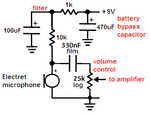jimkess
Member level 4
i am trying the following microphone circuit. In the diagram it says the resistor value depends on microphone. I tried, 10Ohm, 1Kohm, 10Kohm resistors but i get nothing at the output. However when i change the the POT, the value at the output changes which means that connection upto POT is good.
How can i determine the value of the resistor R1 in the circuit. I don't have the datasheet of the microphone but is very typical condenser electret.

How can i determine the value of the resistor R1 in the circuit. I don't have the datasheet of the microphone but is very typical condenser electret.

